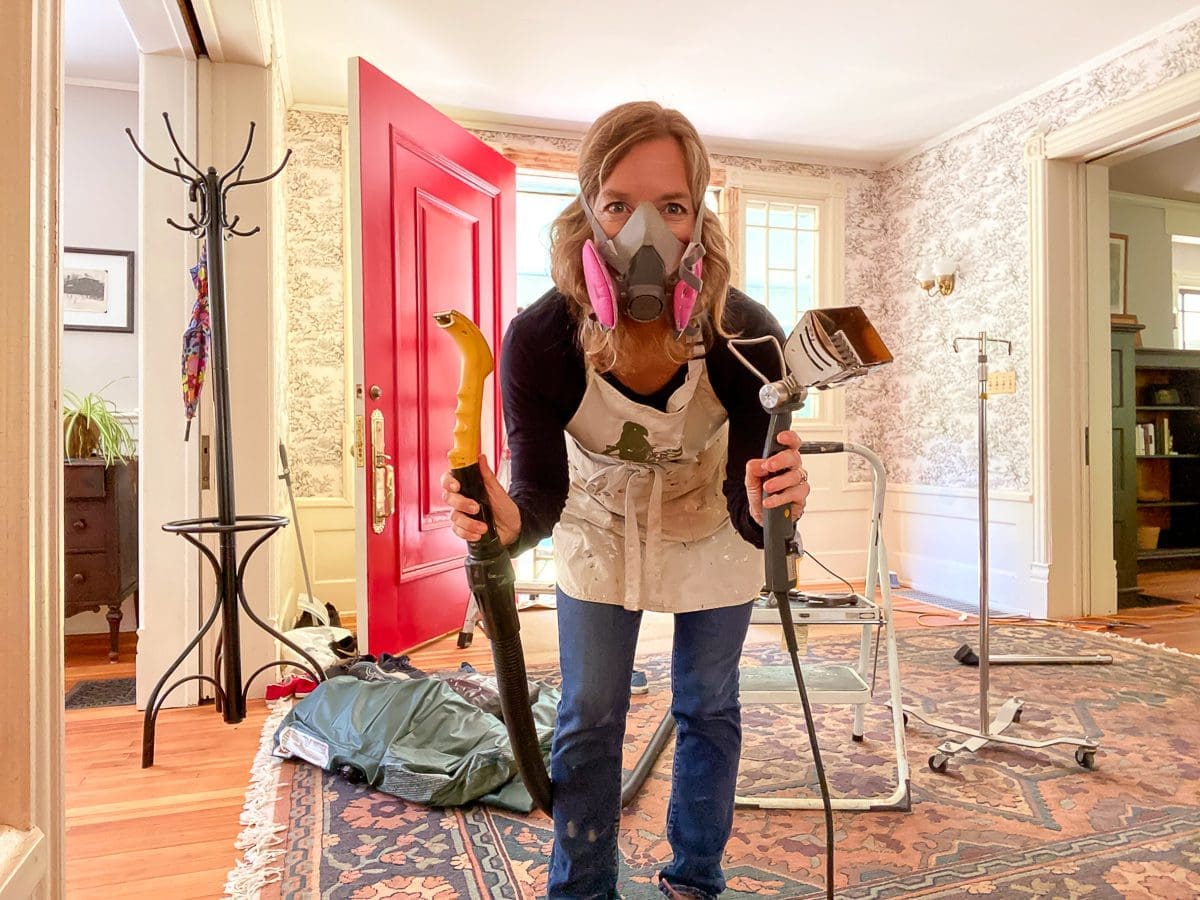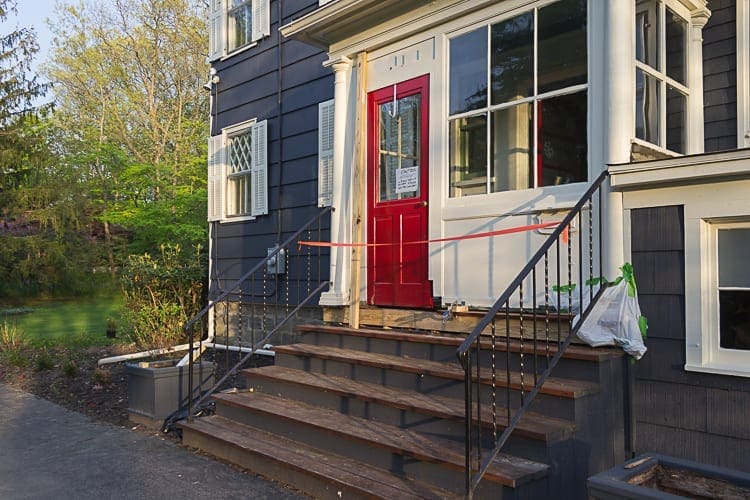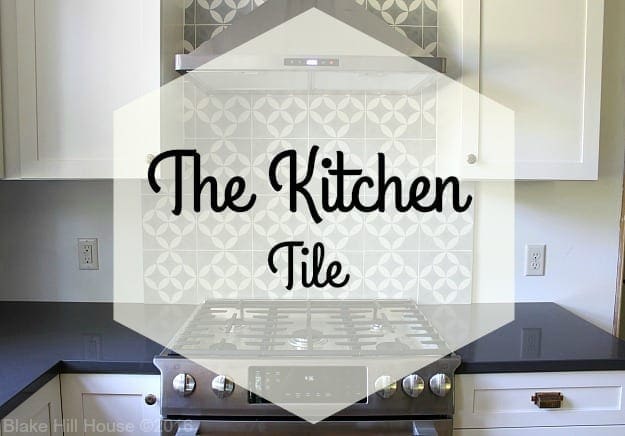I shared a short video of woodwork stripping on Instagram and a bunch of questions about the process followed. So, I thought I would write up a quick post that you can read now or save for later. (Pin it!) First up, safety! Please read and understand the EPA’s Lead-Safe Removal Guide. Most old houses contain lead paint, and at this point, I always assume that lead is present when I work here in BHH. If there is any question, using a lead test swab offers a definitive answer. I usually keep tests on hand, but mostly for items that I bring into the house. Once you understand the risks of lead, you can determine the safety protocols to protect yourself and your family.
This post contains affiliate links.
After I’ve protected the area and donned my PPE, (I always wear a P100 mask, and I prefer these safety glasses.) I start removing paint with my infrared paint remover and a boomerang scraper. I use the Cobra and the scraper from Eco-Strip. The Craftsman Blog sells a less expensive IR paint remover, but I have not tried it yet, so I cannot offer a review. I’ve used the Cobra a ton, and it’s great. Infrared paint removers heat the paint from the inside out without heating it hot enough to release lead vapors. With my Cobra, I generally get almost back to bare wood, but the surface normally has some places where the paint is still a little lumpy.

After removing as much paint as possible with the Infrared paint remover, I switch to my Vacuum Proscraper attached to my HEPA shop vac. (I linked my shop vac, but if you are in the market for one, I suggest waiting for a price drop. There must be a supply issue or something. It is usually closer to $300-$400.)

The Proscraper is great for removing leftover raised areas of paint, and it’s a dream on flats. In many circumstances, I don’t even need to sand the flats after the Proscraper. I use it carefully on curves so I don’t gouge the wood.
Next, I use Mineral Spirits and 000 to 0000 steel wool to smooth and remove leftover paint.

To keep down the lead dust, I damp sand with 80-220 grit. In the photo below, you will see that my woodwork is paint grade Douglas fur, affectionately referred to as Doug “furry.” It’s a real bear to get it smooth. Once the wood is dry, I knock down the fur with 120-220 grit sandpaper with my HEPA shop vac close to catch the dust.

Finally, if there are any stubborn areas, I hit them with a coat of Smart Strip, followed by mineral spirits.

Stripping woodwork is not difficult, but it is time-consuming. For example, it took me about four hours to strip the side trim and jamb of our giant front door. My best suggestion is to turn on a podcast (ahem…True Tales From Old Houses) or music and let the work fade away.

I will be repainting this woodwork, but the steps to get to bare wood are the same. They just take a bit more attention to detail.

I received a question on Instagram about knowing when it’s time to take it back to bare wood. In BHH, we have a paint compatibility issue. Someone painted latex over oil without a proper bonding primer. As a result, most of the woodwork in the foyer looks like the photo below.

Unfortunately, there is no way to repair that issue without taking it all back to bare wood. Another time it is best to strip and repaint is when there are so many layers that the details get lost.
If you have any questions, please leave them in the comments, and happy stripping! Wait that sounds wrong.

Pin it for later!






12 Comments
Melissa
Thank you for the details. I was wondering how to clean up the bits of paint left after using the Cobra. Now I know. I also have corner rosettes, thinking I need a big dose of patience. ?
Stacy
Unfortunately, patience is probably the most necessary skill for this kind of project. Ha!
LC
This is excellent information. I started stripping all my wood doors and jambs and was wondering how you deal with the lead paint when you have kiddos around. I want to start a family soon, but I also know I have a lot of stripping to do in the future with my windows and the rest of the woodwork in my house.
Stacy
You are so smart to think of this in advance. Hopefully, that lead safety guide from the EPA will help you as you move forward.
Jenna
How do you clean up the paint that you scrape off with the infrared paint remover? Do you vacuum it up with the HEPA vacuum? Thanks for the info! We are about to embark on this journey ourselves. Oof.
Stacy
While still wearing my PPE, I sweep up first. Then, I use my HEPA shop vac. Finally, I mop and wet wipe the area. My suggestion is to build in the prep time and clean-up into your project, so you aren’t blindsided by the amount of time it takes in addition to the actual woodwork stripping. Good luck!
Robin
Stacy, I have the latex over oil problem, too. I’ve had excellent results with just scraping off the latex (it comes off easily, of course), sanding, priming with an oil based primer, resanding and then repainting. In other words, I am not stripping down to bare wood (obviously, this only works if you plan to repaint). I just finished the wainscoting on my staircase and the results are swoonworthy!
Stacy
Hi Robin, That is a totally valid option too. Unfortunately, scraping the latex has disrupted the oil base below, and I didn’t want to sand since I know that the oil layer is lead paint.
PS: I’m sorry I didn’t respond to this comment sooner. I missed the notification.
Liz
How do you scrape the paint that is adjacent to the wallpaper without scraping off the wallpaper? I am ruining all of my walls!
Stacy
Oh no! I’m not sure what kind of scraper you are using, but I always use a pull scraper. Pull scrapers are easier to control with two hands. Specifically, I love triangle pull scrapers like this one from Eco-Strip: Boomerang Scraper (Not an affiliate link) It’s expensive, but it’s easy to sharpen the blade, and it is super versatile. I use it for almost every scraping project.
Michelle
Thanks for this! What exactly do you mean by “damp sand”?
Stacy
Hi Michelle, I am sorry I didn’t answer this sooner. Damp sanding is basically spraying the wood lightly with water mist followed by sandpaper to prevent lead dust from leftover lead paint. The downside is that it does raise the grain some, but I’ll often do the final pass with dry fine-grit sandpaper, with my HEPA shop vac following closely behind as I work.